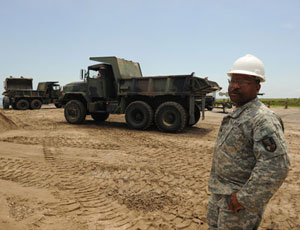As oil from the April 20 Deepwater Horizon explosion began spreading into Louisiana’s marshes, state and local leaders moved ahead on plans to protect the state’s shores with a massive sand-berm project—even without the approval of the U.S. Army Corps of Engineers and the U.S. Coast Guard.

On May 24, Louisiana Gov. Bobby Jindal (R) said the state had directed a dredge, being operated by Weeks Marine Inc., Cranford, N.J., to begin constructing a sand berm at East Grand Terre Island as called for in the state’s barrier-island plan. Plaquemines Parish President Billy Nungesser said he would seek $1 million from his council on May 26 to begin building its own sand ridges along the coast of Plaquemines Parish.
“As long as we can keep it on the sand, we can clean it up,” says Chris Macaluso, public information officer for the Coastal Protection and Restoration Authority (CPRA) of Louisiana.
The $350-million plan, filed with the Corps on May 11, calls for extending the state’s barrier islands with 6-ft-high sand berms for about 90 miles. The plan is a modification of the state’s long-term plans to rebuild the state’s barrier islands to 20 ft above sea level.
“We are trying to narrow the gap” between the islands to reduce the ability of the oil to get to the marshes, Macaluso says. “We are not trying to re-establish the historic footprint. This is not meant to be a permanent barrier.”
Macaluso says the work being done on East Grand Terre Island is not permitted by the Corps but is being done through an emergency work order. He says the CPRA told Weeks to pump the dredge material—sand and silt from just east of the Barataria waterway—outward and around the perimeter of the island.
Steve Chatry, vice president of Weeks Marine, called “relatively minor” the change order to close up a 1,000-ft dike that its single dredge had been using for access to the back of the island. Weeks had been hired to restore 2.5 million cu yd of beach to East Grand Terre Island and 1 million cu yd of marsh fill.
Chatry said that while workers on the job have seen some oil, so far it has not affected operations of the dredge. “It’s obviously a concern,” he says.
Chatry says Weeks also has given input to the state’s plans to build up the sand berms, a plan that Chatry says would use almost “the entire dredging industry’s complement” to rebuild the barrier islands. The state has said it would need 18 dredges, a combination of hopper dredges and hydraulic cutter dredges.
Louisiana also has directed the Louisiana National Guard to close with rocks, sand and sandbags about 40 gaps caused by hurricanes and erosion in the state’s barrier islands, Macaluso says.
The Corps could be close to a decision on the barrier-island reinforcement plan. Louisiana Attorney General Buddy Caldwell spoke with the Corps on May 24 and told a New Orleans radio station the Corps was close to a decision on the project.
Caldwell also sent a letter to the Corps on May 23 saying it was within the state’s constitutional rights to conduct emergency operations, such as rebuilding the islands. Caldwell warned that the state might challenge the Corps’ authority in court if it stood in the way of the plan.
Calls and e-mails to the Corps seeking a response were not returned.
At a May 24 press conference, Coast Guard Adm. Thad Allen, the national incident commander, cautioned that the sand berm would take a long time and might not be effective.
“Building a set of barrier islands and berms that large would take a very, very long time—even by the state’s own estimates, six to nine months in some cases—and a significant amount of resources associated with that might be applied elsewhere,” Allen said.
Allen also said the oil in the marsh was a “worst-case scenario,” with limited cleanup possibilities. He said, in some cases, the best option is to do nothing to remove oil in the marsh; in other cases, it might involve an in-situ burn of the contaminated wetlands.

Post a comment to this article
Report Abusive Comment